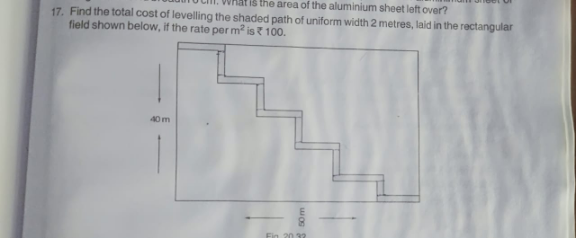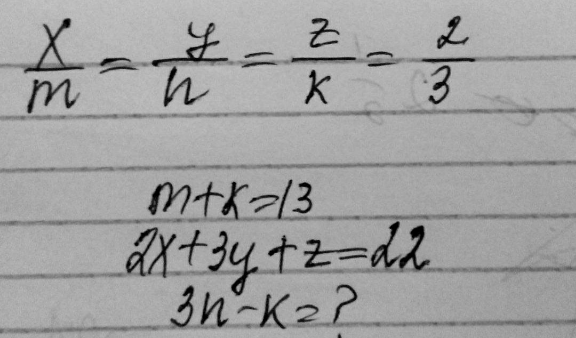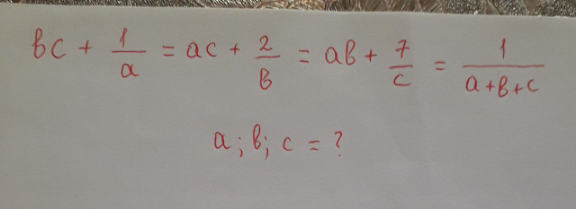
Question and Answers Forum
AlgebraQuestion and Answers: Page 228











Pg 223 Pg 224 Pg 225 Pg 226 Pg 227 Pg 228 Pg 229 Pg 230 Pg 231 Pg 232
|
Question and Answers Forum |
AlgebraQuestion and Answers: Page 228 |
| If f:R→R is a function such that f(0)=1 and f(x+f(y))= f(x)+y for all x, y∈R, then (A) 1 is a period of f (B) f(n)=1 for all integers n (C) f(n)=n for all integers n (D) f(−1)=0 |
| Q1 Let M_2 be the set of square matrices of order 2 over the real number system and R={(A,B)∈M_2 ×M_2 ∣A=P^( T) BP for some non-singular P ∈M} Then R is (A) symmetric (B) transitive (C) reflexive on M_2 (D) not an equivalence relation on M_2 Q2 For any integer n, let I_n be the interval (n, n+1). Define R={(x, y)∈R∣both x, y ∈ I_n for some n∈Z} Then R is (A) reflexive on R (B) symmetric (C) transitive (D) an equivalence relation |
| Solve in real numbers the system of equations { (((3x+y)(x+3y)(√(xy)) =14)),(((x+y)(x^2 +14xy+y^2 )= 36)) :} |

|
| For any integer n, let I_n be the interval (n, n+1). Define R={(x, y)∈R∣both x, y ∈ I_n for some n∈Z} Then R is (A) reflexive on R (B) symmetric (C) transitive (D) an equivalence relation |
| If 3x+(1/(2x))=6 find 8x^3 +(1/(27x^3 )) |
| If a function f:R→R satisfies the relation f(x+1)+f(x−1)=(√3)f(x) for all x∈R then a period of f is (A) 10 (B) 12 (C) 6 (D) 4 |
| Q1 If f:R→R is defined by f(x)=[x]+[x+(1/2)]+[x+(2/3)]−3x+5 where [x] is the integral part of x, then a period of f is (A) 1 (B) 2/3 (C) 1/2 (D) 1/3 Q2 Let a<c<b such that c−a=b−c. If f:R→R is a function satisfying the relation f(x+a)+f(x+b)=f(x+c) for all x∈R then a period of f is (A) (b−a) (B) 2(b−a) (C) 3(b−a) (D) 4(b−a) |
| Given k ∈ N. 1) justify these relations: 3^(2k) +1≡2[8] and 3^(2k+1) +1≡4[8]. 2) Given (E): 2^n −3^m =1. n and m are unknowed. • Show that if m is even , (E) does not have solution. ■ Deduct from the first question 1) that the couple (2;1) is the only solution of (E). |

|

|

|
| Let a<c<b such that c−a=b−c. If f:R→R is a function satisfying the relation f(x+a)+f(x+b)=f(x+c) for all x∈R then a period of f is (A) (b−a) (B) 2(b−a) (C) 3(b−a) (D) 4(b−a) |
| Let a>0 and f:R→R a function satisfying f(x+a)=1+[2−3f(x)+3f(x)^2 −f(x)^3 ]^(1/3) for all x∈R. Then a period of f(x) is ka where k is a positive integer whose value is (A)1 (B)2 (C)3 (D)4 |
| If the roots of the equation 24x^4 −52x^3 +18x^2 +13x−6=0 are α , −α , β and (1/β). Find the value of α and β. |
| let x,y,z be positive real numbers such that x+y+z=1. Determine the minimum value of (1/x)+(4/y)+(9/z). |
| 40−misolning yechimi: y=(x^3 /3)+2x^2 −5x+7 Kritik nuqtalarini topish uchun: 1. Funksiyadan hosila olamiz 2. Funksiya hosilasini nolga tenglab, tenglamani yechamiz. y′=x^2 +4x−5=0 ⇒ x_1 =1; x_2 =−5 x_1 +x_2 =1−5=−4 Javob: −4 |

|
| We are in C. Given Z_(0 ) =1 ; Z_(n+1 ) =(1/2)Z_(n ) +(1/2)i n ∈ N. Show that ∀ n ∈ N^(∗ ) , ∣Z_n ∣<1. |

|

|

|
| Informatica (11110000)_2 =0•2^0 +0•2^1 +0•2^2 +0•2^3 +1•2^4 +1•2^5 +1•2^6 +1•2^7 = =0•1+0•2+0•4+0•8+1•16+1•32+1•64+1•128= 0+0+0+0+16+32+64+128=(240)_(10) (11000101)_2 =1•2^0 +0•2^1 +1•2^2 +0•2^3 +0•2^4 +0•2^5 +1•2^6 +1•2^7 = = 1•1+0•2+1•4+0•8+0•16+0•32+1•64+1•128= (197)_(10) (01101001)_2 = |

|

|

|
Pg 223 Pg 224 Pg 225 Pg 226 Pg 227 Pg 228 Pg 229 Pg 230 Pg 231 Pg 232 |